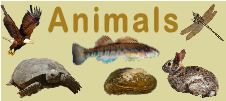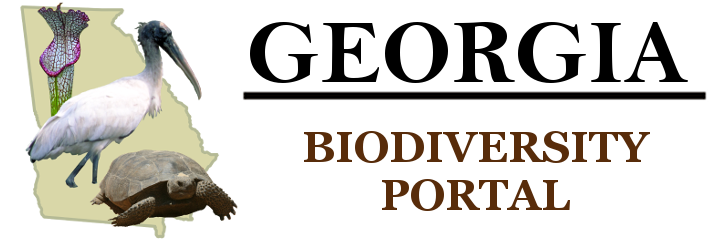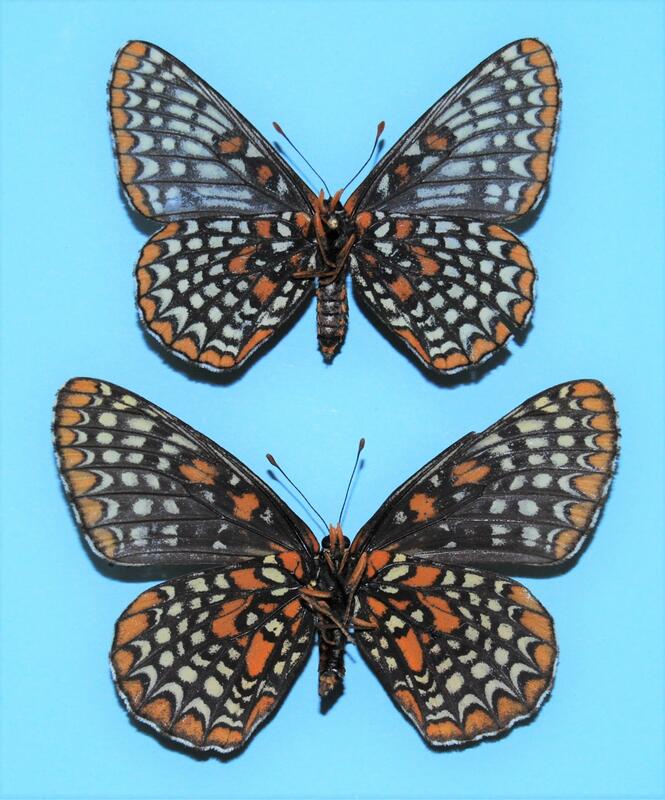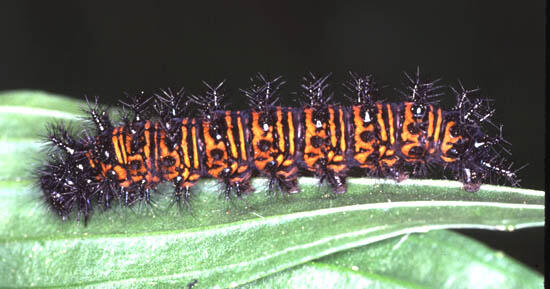






Loading profile. Please wait . . .
Euphydryas phaeton (Drury, 1773)
Baltimore Checkerspot




Federal Protection: No US federal protection
State Protection: No Georgia state protection
Global Rank: G4
State Rank: S2
Element Locations Tracked in Biotics: Yes
SWAP 2015 Species of Greatest Conservation Need (SGCN): Yes
SWAP 2025 Species of Greatest Conservation Need (SGCN): Yes
2025 SGCN Priority Tier: Moderate Conservation Concern
Element Occurrences (EOs) in Georgia: 13
Habitat Summary for element in Georgia: Chattahoochee River parks
This is a dark appearing butterfly with a variable pattern of rows of spots on the upperside and more extensive and variable spotting on the underside. The male pictured above gives a nice representation of the appearance of Euphydryas phaeton. The upperside is black, and typically has an outer row of orange spots along the edge of the wings, and two or three rows of yellow spots across both wings in from the row of orange spots. There are also a couple of small orange discal spots on the forewing. The underside typically has the same rows of spots as the upperside on the outer half of the wings but larger and more extensive; and the base of the wings has larger orange-red spots and yet more scattered yellow spots (see photos above and below). The males wingspan is typically around 5 cm; females can be larger, sometimes signficantly so, than the males (see photo below).
There are no species in Georgia, indeed in the entire eastern U.S., that are even remotely similar to the Baltimore Checkerspot. Even the western U.S. species in the genus Euphydryas, although confusingly similar in comparison to each other, cannot be confused with the eastern E. phaeton.
The Baltimore Checkerspot is found in two distinctly different types of habitats, because of the different foodplants that the females utilize for egg-laying and on which the larvae feed (see below under diet; Harris, 1972). This is a butterfly that is found along riverbottoms where the classic foodplant Turtlehead (Chelone glabra) grows, but also on dry forested ridgelines, where other foodplants have been recorded.
The well known foodplant for the Baltimore Checkerspot (Euphydryas phaeton) is Turtlehead (Chelone glabra). This is the foodplant for colonies found in wet meadows and along riverbottoms in the northern half of the state (Plants database). However, the butterfly is also found on wooded hillsides, sometimes far from sources of water, and other foodplants have been found to support larvae of this species, such as some honeysuckles (Lonicera sp.), Penstemon sp., Viburnum sp., and apparently even narrow-leaved Plantain (Plantago lanceolata).
This butterfly is univoltine, with adults in Georgia flying at some point between the second week in May (pers. obs.) and late June (Harris, 1972), with individuals flying a little later on average in the mountain counties. Females typically lay two to three large egg masses, at least on Turtlehead plants (the behavior could be different on other foodplants), with larvae hatching in about 20 days (Bowers, 1978). At the base of Turtlehead plants, third instar larvae that have stopped feeding construct a "pre-hibernation" web which they occupy for some time from late summer into fall, but subsequently crawl from this web and spin up protective shelters in nearby leaf debris to overwinter (Bowers, 1978). When fresh plant growth begins in the spring, the larvae come out of diapause and complete development. Full grown larvae have a black head and black branching spines on each thoracic and abdominal segment. The body is largely orange with thin transverse black bands on each segment as well (see image, below). Pupation (presumably) occurs sometime between mid-April and mid-May.
This is a difficult butterfly to survey for, and it may be that clusters of larvae feeding on foodplants may be easier to find than adults. This may be especially true if you can look for the "pre-hibernation" webs at the correct time of year (Bowers,1978) as described above. Adults almost invariably seem to be found as single solitary individuals -- this has been my (very scant) personal experience, and Harris in his 1972 book indicates that every one he ever found in Georgia was a solitary individual. Obviously, they must occur at some locations in larger numbers, but adults do seem very elusive.
The Baltimore Checkerspot actually has a large range across much of the eastern U.S. and southern Ontario (except along the Gulf Coast) westward into Minnesota, Iowa, Missouri and northern Arkansas (with outliers in Nebraska, Kansas, the Dallas area in Texas and on James Bay in Quebec; see BAMONA). Yet it is local and uncommon across much of this range, and listed in several of the northeastern states.
In Georgia, adults have been found in scattered locations in the northern part of the state, with at least a few records since 2008 in the Atlanta, Ringgold and Rabun Co. areas. Historically (1980's) it has been found as far south as the Macon area.
It is difficult to anticipate what the threats are to this butterfly in Georgia. It is encountered so infrequently as an adult, and as such, it is difficult to say just how rare this butterfly actually is in the state as a whole. Clearly we are at the southern end of the range, and so climate change may ultimately push this butterfly northward out of the state. At least some of the foodplants are not favorite deer browse and so should not be under significant pressure from large deer populations. Gypsy Moth control could become an issue if Gypsy Moths ever become established in the state. If that happened and the state carries out a plan of spraying Bacillus thuringiensis (Btk) to control Gypsy Moth larvae in the spring, third instar larvae of the Baltimore coming out of diapause could be susceptible to the spraying.
| Threat 1 | Threat 2 | Threat 3 | |
|---|---|---|---|
| General Threat | Natural system modifications | Pollution | Climate change & severe weather |
| Specific Threat | Fire & fire suppression | Air-borne pollutants | Habitat shifting & alteration |
It would seem that this butterfly probably merits an S1 ranking. It has been found in enough locations that it could be ranked S2, but there seems to be little to indicate that any populations regularly persist over some period of time. There is no location that I know of where individuals are seen regularly from year to year.
As this butterfly seems to be found most often as solitary adults, and does not seem to be found regularly in any given area, it is difficult to near impossible to suggest what type of conservation management would be appropriate. It would seem to make sense to make every concerted effort to preserve Turtlehead (Chelone glabra) stands when and where found. This will at least provide the opportunity to maintain or help new colonies establish in the wetlands areas where the butterfly could be found. Still, with the history of finding single adults in different locations with several years passing between sightings, seems to suggest very little about the butterfly's overall population structure in Georgia that would allow this butterfly to be managed.
BAMONA (Butterflies and moths of North America website). Online at https://www.butterfliesandmoths.org/species/Euphydryas-phaeton
Bowers, M. Deane. 1978. Over-wintering behavior in Euphydryas phaeton (Nymphalidae). Journal of the Lepidopterists' Society 32(4): 282-288.
Harris, L., Jr. 1972. Butterflies of Georgia, pages 272-274. University of Oklahoma Press, Norman.
US Department of Agriculture website. PLANTS database. Online at https://plants.usda.gov/java/
James K. Adams, Professor of Biology, Dalton State College
September 2, 2020

